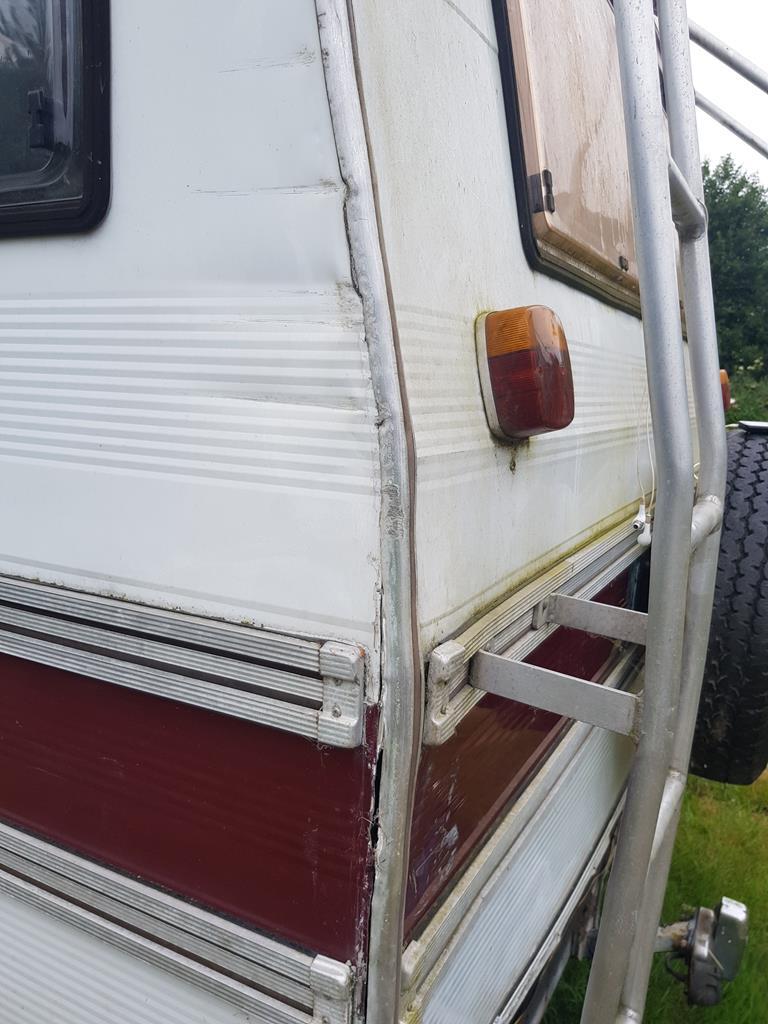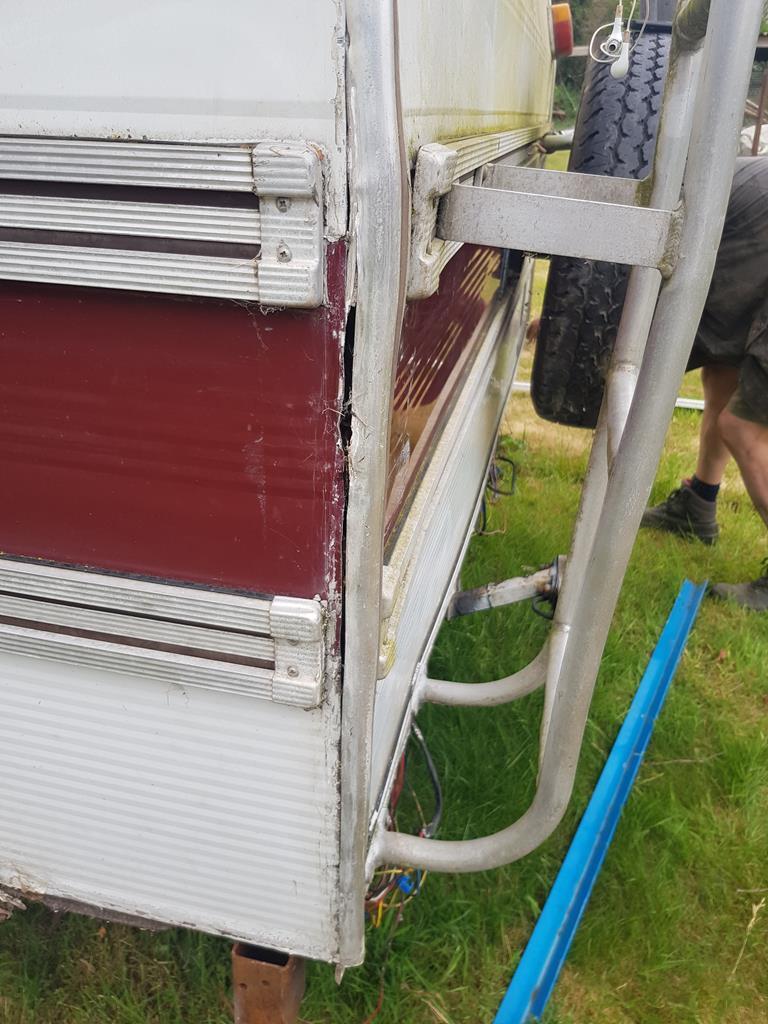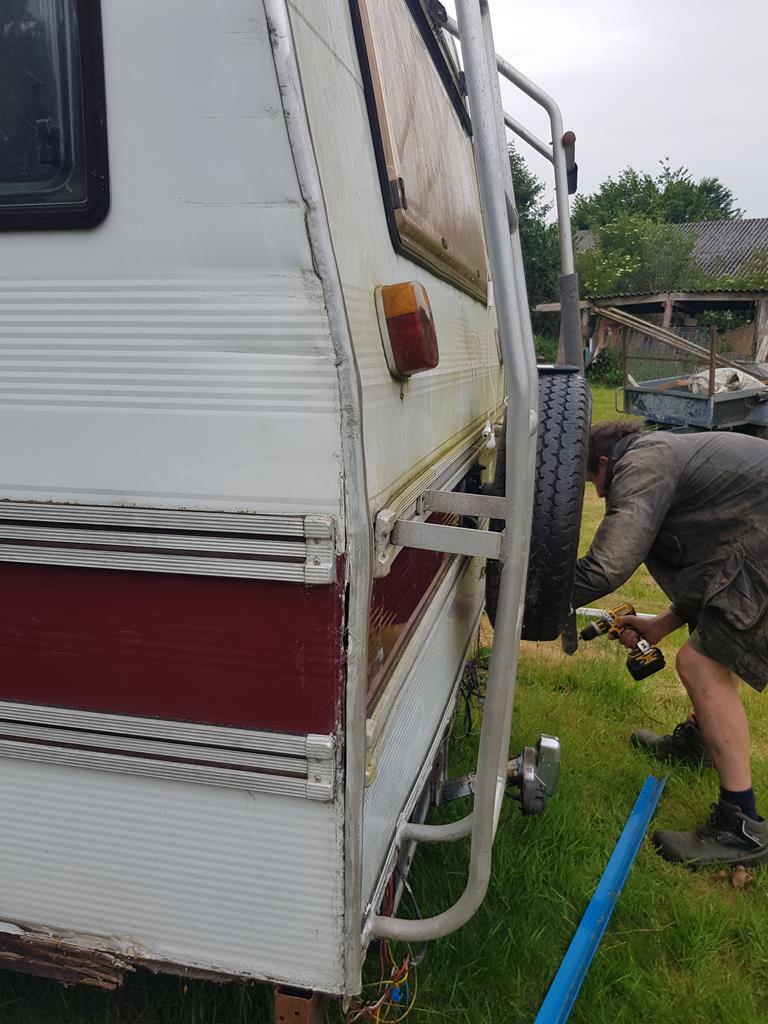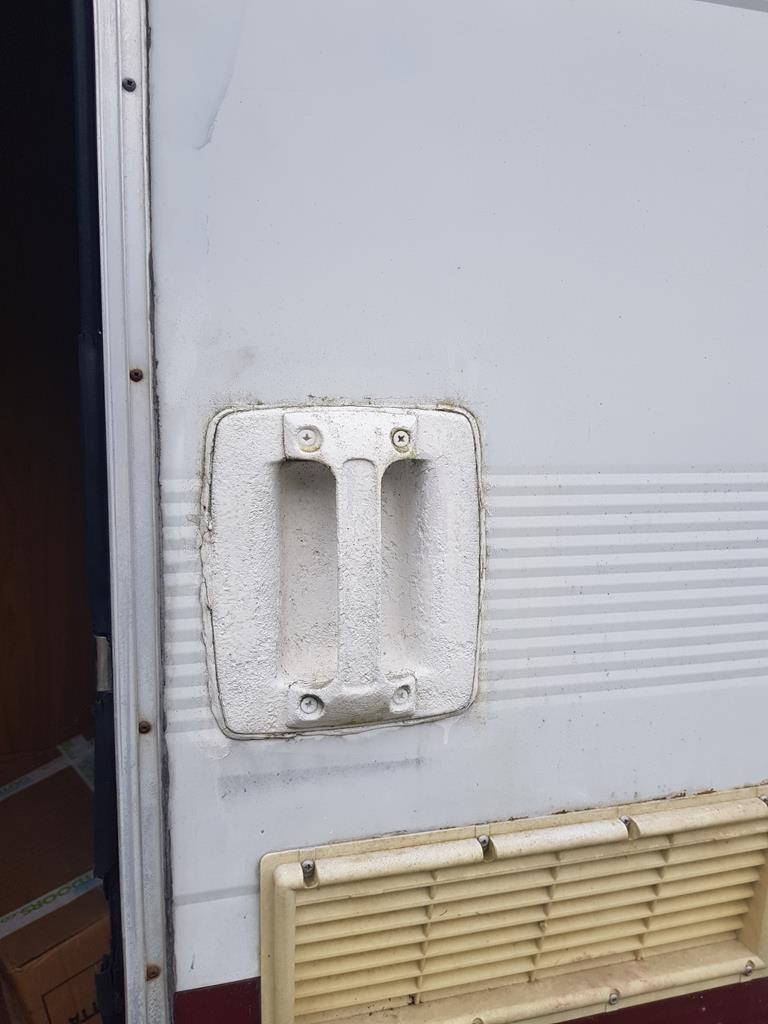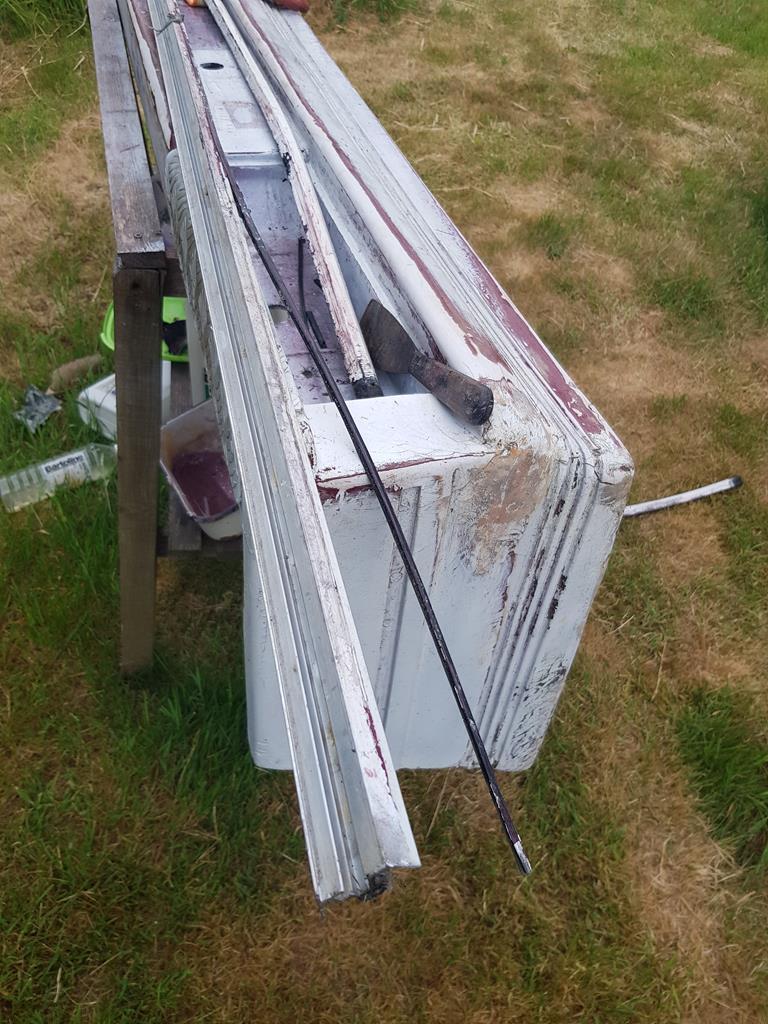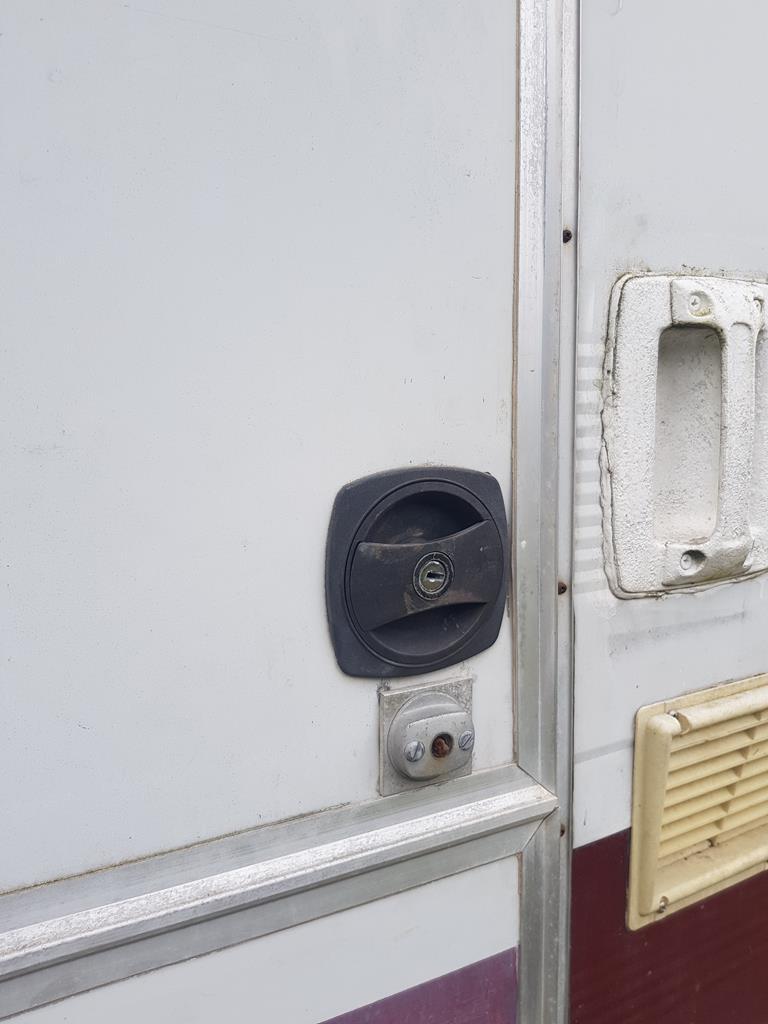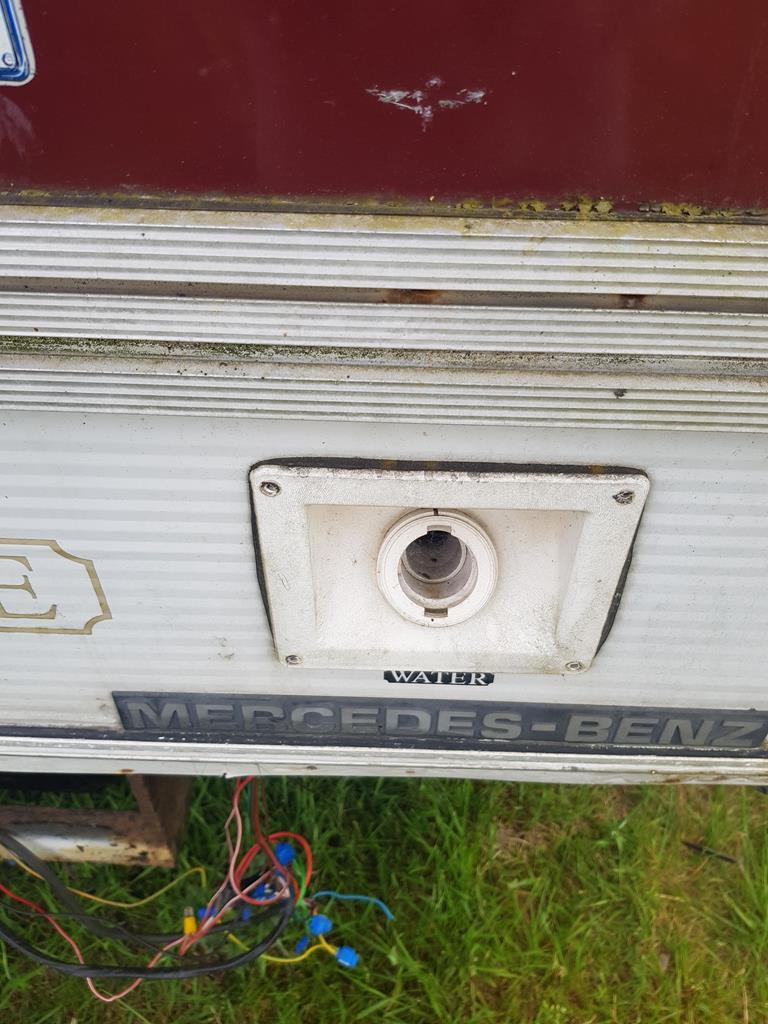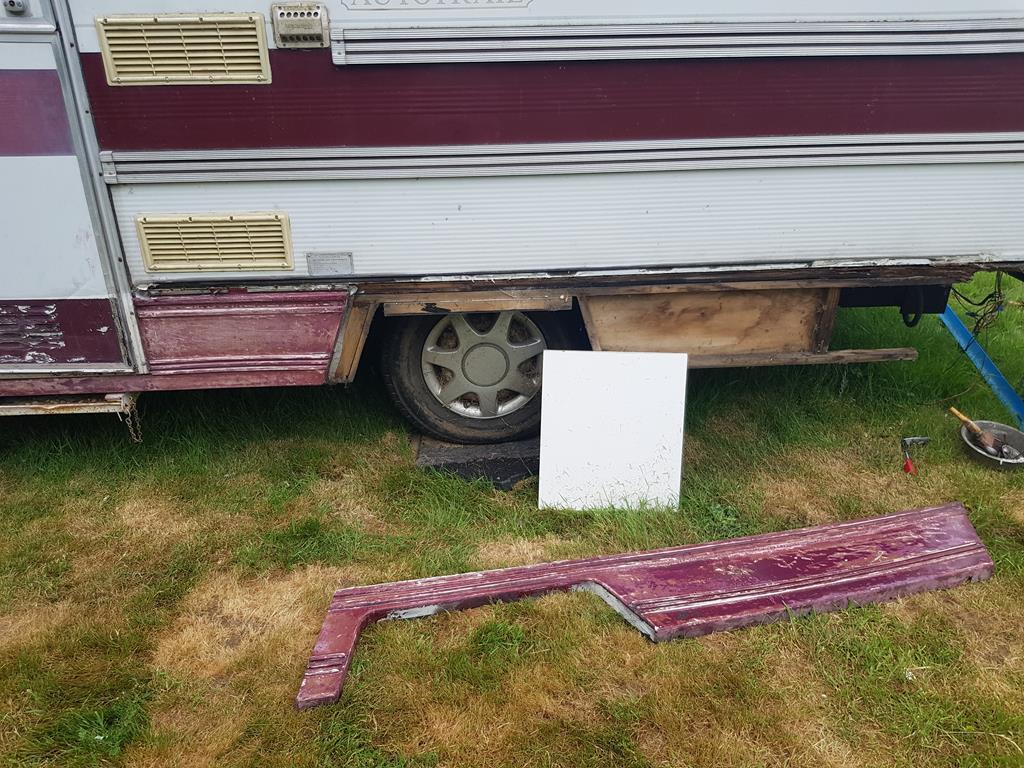A single mains socket was probably sufficient for the needs of the camper van owner in 1990 when they would have had maybe a kettle, hairdrier and possibly if they were fancy a portable telly. In 2020 however not so much. Thinking about it though, we don't actually have much call for direct access to actual mains electricity these days...I think the only thing which is routinely plugged into the socket in there is the vacuum cleaner. 99% of our things are battery powered these days, and nearly all of them at least in our case charge from a USB socket these days.
The single socket was therefore swapped out for one with an inbuilt USB charger.

The round pin socket is a 12V DC outlet. The only thing I currently use it for is to hook up the submersible transfer pump for shifting water from the Aquaroll to the onboard tank. I'm not likely to even need this much longer as my intention is to fit a 12V socket outside for that purpose to save me having to dangle leads out the window. Once that's done I will probably replace this with a 12V based USB charger solution, assuming I can find something that will fit into a standard faceplate. The mains meters aren't really necessary, but are simply there to act as a visual indicator that the mains hookup is connected and live. I do need to tweak the position of the ammeter though, it's a hair too low.
As I had a hole in the front of the locker where the original controller for the new heater had been so this made sense as a place to install a second mains socket. That gives is four USB sockets in relatively close proximity of the bed, that should be sufficient to keep everyone's phones and assorted tech charged hopefully.

That red switch to the right of the socket by the way is the master switch for the heater and controller.
While I had the locker open it seemed a good time to attack a few of the other tasks I'd been putting off sorting in there.
A lot of these matters surrounded the heater.
Particularly I had been wanting to add a bit more of a safety margin in the "Making sure it can't set fire to stuff" department for a while...but especially now that the new controller is fitted, which essentially has command authority to start the heater up under certain circumstances now irrespective of whether the van is occupied or not.
When I originally installed it, I cut the hole in the floor for the air intake and exhaust lines using the nice little template in the instruction manual.


I did foil line everything after that trial fitting by the way.
At a glance this might seem fine enough, especially given the original 1.5kW gas heater didn't bother with any clearance...but it's very easy to forget how powerful this thing is. 5kW is a lot.
Putting that into perspective, the most powerful electric heater that you can plug into a domestic electrical socket is 3kW. So this thing kicks out some serious heat - a significant portion of that being that it's combustion based goes straight out the exhaust. So it gets toasty. Toasty enough to have blued the metal over the entire length of the exhaust. I'd *really* rather have more than 1/2" clearance between that and my floor thank you very much.
That teeny tiny hole was made rather larger to get the floor further away from the exhaust.

Then some heat reflective tape was applied around it (this stuff has adhesive sufficiently strong to remove your fingerprints), wrapping well around onto the underside of the floor on all sides - there are three or four layers here.

I will obviously go back and trim some of the excess later.
While I had the heater free of the floor it seemed a good opportunity to replace the worryingly squidgy original fuel line to the burner with a nice bit of Nautilus Fuel Master, I trust that a couple of inches away from a burner exhaust far more than something that came in a box from China that has nothing by way or markings on it.

I wrapped the first couple of inches in foil as well...I know this hose won't need it, but it makes me rest easier knowing I've given that extra layer of protection.
It's very clear that the exhaust hasn't been fully sealed, so I made sure to put a smear of sealant on there before it was reattached.
In the cabin I wanted to make an alteration to the outlet. Previously I had just hooked it in to the lower one from the original heater because it happened to line up nicely. This wasn't ideal however as it results in the lower panel of the door getting very warm, but the rest of the van taking a good deal longer to warm up than it needs to. Being completely flush with the front of the locker made it far easier than I'd like to block the outlet completely too. So an adjustable outlet was fitted into the upper cut out instead.

The lower one serves as a return duct, though obviously it's not exclusive as the locker is far from airtight. I will add a grill or screen to it at some point just for aesthetics and to try to stop quite so much dog hair finding its way into the locker.
I do want to add some additional ductwork at some point though. Rather than the one outlet we currently have I'd like to branch three lines off. One venting out the rear of this locker to heat the kitchen area, likewise at the front towards the cab (or possibly an adjustable one like above) and I'd like to tap off a small line to provide a little background heat into the bathroom. I don't need it to be as well heated as the rest of the van, but currently it's like walking into a freezer in there at night. It's a job for the future, but would definitely make things more comfortable. Would probably make the heater a bit quieter too. Decent safety feature too as you'd have to be trying pretty hard to block off four outlets at the same time.
With the heater back in place I started doing something I should have months ago, and generally tidied things up a bit. It's always going to be a bit of a rat's nest down here with all the wiring, but I can at least try to tidy it up! It's still a work in progress as I ran out of time today, but we're getting there.


The conduit will obviously be attached to the side of the locker once I'm finished. There will likely be one along the other side too as there are quite a few random wires wandering along that way. Still need to remove the remains of the old gas line for the old heater as well.
That carpeted box all the mains stuff is sitting on I'd really like to get rid of. It just makes accessing anything incredibly awkward. I may well just pick up a small consumer unit like the ones for sheds or garages and redo that whole lot from scratch at some point as this is just a mess. Especially bearing in mind I've vague plans to install solar on this van at some point in which case I'll definitely be wanting to bring some sanity to this spaghetti. The DC stuff is a mess too, there's a lot of nonsense like red wires being used for multiple purposes (as you can see on the battery charger output at about 1 o'clock in the above photo) that I inherited with the van. I'm guessing that's a former keeper to blame rather than the factory...though with hand built vehicles you sometimes just never know...
Before anyone says the supply line to the front socket is too small, it will be fine. It's rated for 13A, and the two sockets are both attached to a single 7.5A RCD, so it will never be stretched. I'd be massively surprised if anything ever gets plugged into the mains socket up front anyway!
I would really like to install a guard of some sort to ensure that there's no way that the air intake on the heater body could be accidentally blocked. I will probably install a partition to separate the utility area at the rear from the general luggage locker at the front. That should do a pretty good job of keeping things away from where they shouldn't be. Though I will need to include some means to still stow the supports for the awning (the metal things to the left in the above image) as they do extend a fair ways back.
It was at this point we ran into a slight snag which took me a couple of hours to get to the bottom of.
Having changed the fuel line I needed to re-prime it. Didn't figure it would need much though given it was only the 10" or so between the fuel pump and the burner. Plan was to just run the pump in priming mode for 10 seconds or so. Given the control panel is a bit awkward to get at when the locker is open like this I decided to use the web interface to do this. Which would have been fine if my phone hadn't decided to drop my wifi connection the millisecond that I turned the pump priming mode on. I then spent a good minute fighting with it before realising that I could just turn the master switch off.
I was expecting this to result in some pretty impressive white smoke on startup then as there would obviously be quite a bit of unburned fuel having been dumped into the burner. It should clear after running for a bit though.
Except it didn't. In fact it got worse, and started to become denser and darker. This just doesn't look right.


It was also lingering impressively enough to attract the attention of our next door neighbours.


Something clearly wasn't right.
Thanks to the additional data visible on the Afterburner display it was obvious in addition to the smoke that it was struggling to make it up to full running temperature. The heat exchanger usually stabilises at full power around 220C, however it was struggling to get over 120C, despite blanketing half of our neighbourhood in smoke and the fuel pump running at the maximum rate of 5.0Hz.
After a certain amount of head scratching, and messing around swapping controllers back over in case it was a problem with the fuelling map etc, the fault was found.

You remember how I put some sealant on the exhaust? Yeah...a bit of it had managed to ooze into the pipe itself, where it had then puffed up when the pipe heated up and blocked a good 2/3rds of the pipe. So we were getting poor airflow due to a choked exhaust.
Once the system was started up with this removed and it started to get actually up to temperature the amount of soot that got blasted out the exhaust was truly impressive. There were honestly bit chunks of it. Not quite the fireworks you sometimes see from DPF equipped cars doing the first forced regen after months of town driving, but still impressive enough.

It did smoke for quite a while too, though given it spent probably an hour running with a very restricted exhaust that didn't really surprise me. It did clear up though after 20 minutes or so, and the heat exchanger temperature soon stabilised at its normal level.
Stupid mistake on my part using too much exhaust sealant! Entirely self inflicted.
I set the temperature control to max and just left it running for a full hour at full throttle to make sure everything was properly cleaned out. This also meant I was able to check and confirm that the floor around the cutout under the van is no longer getting worryingly hot. The fixing plate still gets quite warm, so it does get pretty toasty, but no longer *alarmingly* hot! Given it only takes about 20 minutes to get the cabin from 0C up to a comfortable temperature anyway it's pretty unlikely to be left running flat out for all that long anyway so this was a pretty good test from that perspective.
Hopefully get most of the remaining tidying up of the locker done tomorrow.
![]()
